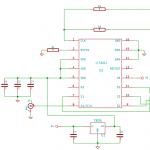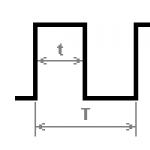Users of Android smartphones or tablets sometimes encounter the problem that the phone does not recognize the USB flash drive. Now we will try to figure out what this is connected with and what to do.
Why doesn't my phone recognize the USB flash drive?
Devices running the Android operating system allow you to connect external storage devices, for example, a USB drive, a hard drive. This is done using a special cable called OTG. So, let's look at why the phone can't see USB flash drive.
If you need a high-quality and inexpensive USB flash drive, order it.
Reason 1: The device does not support OTG
To connect external drives to the device, it must support On-The-Go technology. Its essence is that the phone supplies power to the storage device or hard drive via an OTG cable. You need to check whether the device works with this technology:
- Let's go to Play Market, enter USB OTG Checker in the search bar.
- Install the first application from the list of results.
- Let's launch it.
- If it shows that everything is fine, you can connect the OTG cable and the drive.


This is one of the reasons why the phone does not see the USB flash drive through the OTG adapter.
Reason 2: Android version
Must be installed on your phone operating system Android starting from version 3.1, below does not support USB 2.0 and 3.0.
Reason 3: File system format
Devices on which it is installed official firmware file systems supported:
- exFAT;
- FAT32.
Unfortunately, the phone will not work with others. There are two options:
- Format your drive for the desired file system.
- To install an application that supports other file systems, however, you will need root rights.
Of course, the second method is convenient; you don’t have to delete anything from the drive, but not every user has root rights and not everyone knows how to do this. Therefore, the easiest way is to simply format the drive through a computer. This is done quite simply:

Please note that during the formatting process, all data on the drive will be destroyed.
Reason 3: Lack of nutrition
It’s rare, but it still happens that the phone does not provide enough power to operate a flash drive or external hard disk. In this case, there is only one way out - to use an active USB hub to which external power is connected.

In this case, mobility is, alas, out of the question.
Reason 4: The connector is damaged

The connector where the OTG cable is connected may be faulty, and even if charging goes through it, this does not mean that it is working. The contacts responsible for data transfer may not be working. In this case, you need to go to the service center.
Reason 4: The OTG cable is damaged

One of the reasons why the phone does not see a flash drive connected via an OTG cable is a malfunction of the cable itself. You need to connect it to another device and connect a flash drive to it; if the drive goes unnoticed, you need to change the cable.
Reason 5: OTG power controller burned out
Sometimes it happens that an Android smartphone does not supply power or does, but not enough. This can be checked:

In this case, you need to take the device to a service center.
How to connect a USB flash drive to your smartphone

To avoid unnecessary questions, it is worth writing brief instructions How to connect a USB flash drive to a smartphone:
- Take the OTG adapter. It must have a USB connector. To buy an adapter of the required standard, it is better to go to the store with a smartphone, then you will definitely get what you need. If there is an OTG, connect it to the microUSB connector of the phone or tablet.
- You need to connect a flash drive to the USB connector of the OTG cable.
- Then you should go to the address sdcard/usbStorage in your smartphone’s file manager, the contents of the drive will be there.
Here's how to connect a USB drive to your smartphone.
If there is no OTG function
Some users are wondering how to connect a USB flash drive to a smartphone if it does not have the OTG function. Unfortunately, there are no smartphones with USB ports, as they are quite large. The only option is to use an OTG adapter; connecting a flash drive to a phone without OTG is unrealistic.
Conclusion
Now you know why your smartphone doesn’t see the flash drive and what to do if it doesn’t have the OTG function. Study this material carefully and everything will become clear.
If you urgently need to transfer some files from your phone, tablet or Android smartphone to a USB flash drive in order, for example, to clear the memory of your device or quickly transfer something to a friend’s drive, you can do this thanks to some additional purchases. Below we will tell you how you can connect a flash drive to an Android device, and what you need for this.
How to connect a flash drive to an Android smartphone or tablet
This will give you the opportunity to connect a USB flash drive to your device anytime and anywhere, but you will have to shop a little.
Using OTG cable
The only thing you need to use this method is to go to a store or order an OTG cable online. This is a kind of adapter from your MicroUSB input on the device to USB. It is inexpensive, around 150–300 rubles, so this option seems to be the most practical. But be careful, before buying a wire, check which input is on your phone/tablet. Select the necessary adapter for your device; if you don’t find one, then you will simply have to buy another adapter from the OTG cable to your gadget.
On the left is an input for USB, on the right is an adapter for MicroUSB of your device
Types of MicroUSB and MiniUSB:

Via apps
After purchasing a complete set of cords, simply connect all the components, and the flash drive will automatically be detected on your device. But the phone may not have built-in support for an OTG cable (most modern mobile devices have this function), then there are two options:


To work with Nexus Media Explorer, just launch the application when the flash drive is inserted into the OTG cable and it is inserted into the phone. StickMount will have to be configured a little:

Now that your tablet or phone has identified the flash drive, you can start browsing and moving everything from place to place by going to the explorer installed on your phone. If you do not have such a program, then download ES File Explorer (ES Explorer) from the Play Market (https://play.google.com/store/apps/details?id=com.estrongs.android.pop) or any other similar in terms of functionality of the application.

Install the application from Play Market
Video tutorial: connecting a USB drive to an Android device
The only way to connect a flash drive to your Android tablet or phone is to use an OTG cable, which will serve as an adapter from the MicroUSB input to the drive connector. If the device does not see the flash drive, use one of the programs suggested above. After successful detection, go to Explorer and perform any operations involving transferring and editing files.
On a smartphone you will not find a full-fledged USB port into which you can insert a flash drive. Therefore, connecting a USB flash drive to Android must be done using additional equipment.
Connecting the drive
For your phone to see and open devices connected via USB, it must have On-The-Go (OTG) support. The essence of the technology is that mobile device supplies power to external equipment via a USB connector. The function is implemented in Android 3.1 and higher, so before you try to connect a flash drive to Android, you need to make sure that this is even possible. First of all, check the OS version:
To make sure there are no problems with the connection, install the USB OTG Checker application. This small program will check for OTG support and, if available, issue a confirmation.  The next step is to purchase a special adapter (equipment cost starts from 100 rubles). The smartphone has a microUSB port; the flash drive physically cannot fit in it. Therefore, you need to expand the port using an OTG adapter, which can be bought at any store mobile technology. Some phones, like tablets, come with a “native” OTG cable, so manufacturers also assume that external drives and other USB devices will be connected to their devices.
The next step is to purchase a special adapter (equipment cost starts from 100 rubles). The smartphone has a microUSB port; the flash drive physically cannot fit in it. Therefore, you need to expand the port using an OTG adapter, which can be bought at any store mobile technology. Some phones, like tablets, come with a “native” OTG cable, so manufacturers also assume that external drives and other USB devices will be connected to their devices.  The connection procedure itself is extremely simple: one end of the adapter is installed into the microUSB connector on the phone, and into the existing one at the other end USB port flash drive is inserted.
The connection procedure itself is extremely simple: one end of the adapter is installed into the microUSB connector on the phone, and into the existing one at the other end USB port flash drive is inserted.  Now you can find universal flash drives with USB and microUSB, which do not require an adapter to connect.
Now you can find universal flash drives with USB and microUSB, which do not require an adapter to connect.  This is still rare, but it is quite possible that over time the ports will become universal, and users will be able to abandon adapters and other additional equipment.
This is still rare, but it is quite possible that over time the ports will become universal, and users will be able to abandon adapters and other additional equipment.
To open a flash drive on a tablet or smartphone, it is usually enough to have the file manager. The flash drive must be formatted in FAT32; data from NTFS cannot be read on Android. This primarily applies to latest models smartphones from Samsung: just connect the flash drive via an OTG adapter and find the drive through any file manager. The data will be located in the /sdcard/usbStorage directory.  However, the procedure does not always go so smoothly: even if the device supports OTG, the question of how to open a connected flash drive on Android causes difficulties. The problem is that not all mobile devices are automatic mode install external equipment, be it a flash drive, camera or mouse.
However, the procedure does not always go so smoothly: even if the device supports OTG, the question of how to open a connected flash drive on Android causes difficulties. The problem is that not all mobile devices are automatic mode install external equipment, be it a flash drive, camera or mouse.
The shortcoming can be eliminated using paid application USB Media Explorer, which allows you to copy music, video photos, documents from flash drives connected to Google Nexus smartphones and other devices with Android 4.0 and higher.  The application has two drawbacks: it is paid and correct work is guaranteed only on Nexus phones and tablets, although the developers claim support for other devices. Advantages: support file system NTFS, that is, you do not have to format the flash drive to FAT32 before connecting.
The application has two drawbacks: it is paid and correct work is guaranteed only on Nexus phones and tablets, although the developers claim support for other devices. Advantages: support file system NTFS, that is, you do not have to format the flash drive to FAT32 before connecting.
If you don’t want to spend money on an application for copying data, or you basically can’t install USB Media Explorer on your device due to lack of model support, then the only way to access the data recorded on the flash drive is to use superuser rights (root).
For each model, it is better to look for its own separate instructions for obtaining superuser rights. There are also universal methods, type of use Kingo programs Root, but keep in mind that obtaining root rights is a potentially dangerous operation, as a result of which the mobile device will be removed from warranty. In addition, performing the procedure incorrectly may damage the system.

If your phone has root rights, you can use free application StickMount to detect a connected flash drive on Android.
- Launch StickMount.
- Connect the flash drive to your phone.
- Set StickMount to open automatically when this drive is connected and give the application superuser rights.
You can view and copy the contents of the flash drive after mounting through any file manager. The information will be located in the sdcard/usbStorage directory. 
Android OS tablets today are positioned as full-fledged workplaces. It's no joke, they actually already know a lot, including working with numerous USB peripherals. Mice, keyboards, printers, game controllers and many other devices are connected to tablets using a special cable. But, without a doubt, the most familiar and popular USB device, familiar to everyone, is a regular USB flash drive. In today's article you will learn how to easily “make friends” of your tablet with absolutely any flash drive.
What is USB-OTG? This technology appeared back in 2001 and was intended for the same thing it is used for now: connecting USB devices to gadgets like mobile phones and wearable media players. Key Feature OTG is that head unit(in our case, a tablet) can work in both “host” and “client” modes.
In other words, through the same port, our tablet can not only work with a flash drive, but also act as one itself when connected to a PC via the appropriate cable.
How does this work
But how exactly does this all work? Surprisingly, the technology has not undergone any significant changes since its invention. In order to switch the tablet to the “host” mode, the OTG cable is equipped with a special jumper, which is not included in the regular USB cable included in the kit. Thanks to this jumper, the tablet “understands” that this particular cable is connected and “gives” energy to the flash drive, rather than receiving it, for example, for charging. Sounds pretty simple, doesn't it?
By the way, on at the moment There are devices that allow tablets to work with OTG and charge at the same time, which is incredibly convenient for several reasons. Instead of a jumper, they use resistance (resistor) and voltage with charger is supplied not only to the tablet itself, but also to the flash drive connected to it. Unfortunately, this function Not all tablets support it yet.
Possible problems when connecting OTG
Sometimes it happens that your cable is working properly, but for some reason the tablet stubbornly refuses to “see” external device. We'll look into why this might happen below.

What to do if OTG does not work
If you have read the list and know why OTG does not work, let's try to find several solutions to your problem.

However, it often happens that the capabilities of FAT32 become insufficient. The fact is that this file system has one significant drawback - it does not support working with files larger than 4 GB. This drawback can be very critical for those who like to watch movies on their tablet. high resolution. NTFS does not have such a problem, and this is where the question arises of how to teach our tablet to work with this file system. There are several ways to do this. The simplest is to install programs that allow you to mount NTFS on any device running Android OS. The most common one among them is “Paragon NTFS & HFS+”. It is distributed free of charge and allows you to mount not only NTFS, but also HFS+, which Apple uses in its Macs. The program is very convenient and simple. Its only drawback is that you need ROOT rights to work with it.
- As for portable HDDs. As noted above, most of them will not work with tablets due to higher power consumption. How can we deal with this problem?
The first option is an active USB hub. This regular USB-hub, but with external power supply, allowing you to connect more devices without loss of speed. Flaw this method— not all tablets support hubs, plus an additionally occupied outlet.
Example of an active USB hub
The second option is HDD with external power supply. It’s not just tablets that lack the “strength” to promote external HDDs. Some laptops also cannot cope with this task, so you can often find HDDs with two USBs on sale. One goes into the tablet, the second goes into the charger.
But the HDD with external power supply
Do not forget that almost all HDDs are formatted in NTFS, so before connecting hard drive to the tablet, it’s worth taking care of this too.
The basics of working with external drives
So, we connected the flash drive to our tablet, what next? All modern file managers support USB-OTG. The most popular and functional is “ES Explorer”. In order to “get” to the flash drive, you need to select the appropriate item in the main menu. Now you can view files on it, edit them, copy, delete and perform any actions with them, just as you do with a microSD card or the memory of the tablet itself.
Main menu of the ES Explorer program
USB drive opened in the program
If it is not possible to install a file manager, you can find a flash drive connected to the tablet through the manager built into the firmware. Some standard FMs are capable of displaying external flash drives in the main menu, like “ES Explorer”, while others require you to independently search for external drives. You can find a USB flash drive at the following address - root of the tablet memory (root) - storage - usbdisk.
Tablet memory root
And here is the flash drive itself
The read/write speed depends both on the flash drive itself and on the characteristics of your tablet. New devices that support USB 3.0, for example, allow you to work with external drives at speeds that are in no way inferior to internal memory.
You can test a flash drive for read/write speed on Android, for example, using the “A1 SD Bench” program.
A1 SD Bench program
Is it possible to “make friends” between two Android tablets via OTG?
Surely, this is a question that interested many after reading this article. There are situations when you need to convey large volume information from one tablet to another. For example, a folder with photos, big game or a movie of a gigabyte or two in size. Of course, even if the tablet has the latest version of Bluetooth, you will have to wait more than one hour. This, of course, is not an option. This begs the question, is it possible to connect two Android tablets or smartphones to each other via OTG? The answer is yes. However, there are some limitations. WITH latest versions Android Google is gradually moving away from mounting device memory as USB drives. Now most Android devices are connected using the MTP protocol, that is, as media devices, since this is more secure from a corporate point of view.
Smartphone connected via MTP
What does this mean? And the fact that Android does not currently support MTP connection to it. You can get around this by switching your smartphone or tablet to standard storage mode using the corresponding item in the settings. If there are no such settings, you can try to do this using special programs. Unfortunately, these programs are not a panacea and will not work with every tablet.
If the tablet does not work as a drive
As a result, if your tablet does not work as a storage device, you have only one outlet for transferring a large amount of information - WiFi. The essence of such a transfer is the following - one device is the host and opens the access point, and the other is the client, which, in fact, connects to this point. Today, many programs allow such transfer, for example, the same “ES Explorer” or the MiDrop function of Xiaomi. But the most convenient program is SHAREit
Although it was copied from the Transfer application in MIUI (they even connect without problems), it is supported by all Android devices and provides enormous data transfer speeds. There is no comparison with Bluetooth. In addition to this, it looks nice, is very easy to use and allows you to transfer data even to Apple products. In general, this is truly a “must have” for any Android device.




